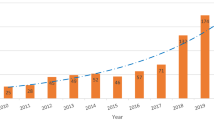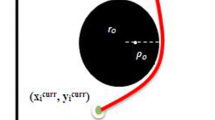Abstract
The Darwinian Particle Swarm Optimization (DPSO) is an evolutionary algorithm that extends the Particle Swarm Optimization (PSO) using natural selection, or survival-of-the-fittest, to enhance the ability to escape from local optima. An extension of the DPSO to multi-robot applications has been recently proposed and denoted as Robotic Darwinian PSO (RDPSO), benefiting from the dynamical partitioning of the whole population of robots. Therefore, the RDPSO decreases the amount of required information exchange among robots, and is scalable to large populations of robots. This paper presents a stability analysis of the RDPSO to better understand the relationship between the algorithm parameters and the robot’s convergence. Moreover, the analysis of the RDPSO is further extended for real robot constraints (e.g., robot dynamics, obstacles and communication constraints) and experimental assessment with physical robots. The optimal parameters are evaluated in groups of physical robots and a larger population of simulated mobile robots for different target distributions within larger scenarios. Experimental results show that robots are able to converge regardless of the RDPSO parameters within the defined attraction domain. However, a more conservative parametrization presents a significant influence on the convergence time. To further evaluate the herein proposed approach, the RDPSO is further compared with four state-of-the-art swarm robotic alternatives under simulation. It is observed that the RDPSO algorithm provably converges to the optimal solution faster and more accurately than the other approaches.
Similar content being viewed by others
Explore related subjects
Discover the latest articles, news and stories from top researchers in related subjects.References
Bonabeau, E., Dorigo, M., Theraulaz, G.: Swarm Intelligence: From Natural to Artificial Systems. Oxford University Press, New York (1999)
Kennedy, J., Eberhart, R.: A new optimizer using particle swarm theory. In: Proceedings of the IEEE 6th International Symposium on Micro Machine and Human Science, pp. 39–43. Nagoya (1999)
Tillett, J., Rao, T.M., Sahin, F., Rao, R., Brockport, S.: Darwinian particle swarm optimization. In: Proceedings of the 2nd Indian International Conference on Artificial Intelligence, pp. 1474–1487 (2005)
Liu, Y., Nejat, G.: Robotic urban search and rescue: a survey from the control perspective. J. Intell. Robot. Syst. 72(2), 147–165 (2013)
Parker, L.E.: Multiple mobile robot systems. Springer Handbook of Robotics, pp. 921–941 (2008)
Couceiro, M.S., Rocha, R.P., Ferreira, N.M.F.: A novel multi-robot exploration approach based on particle swarm optimization algorithms. In: Proceedings of the IEEE International Symposium on Safety, Security, and Rescue Robotics, SSRR2011, pp. 327–332. Kyoto (2011)
Couceiro, M.S., Rocha, R.P., Ferreira, N.M.F.: Ensuring ad hoc connectivity in distributed search with robotic darwinian swarms. In: Proceedings of the IEEE International Symposium on Safety, Security, and Rescue Robotics, SSRR2011, pp. 284–289. Kyoto (2011)
Couceiro, M.S., Martins, F.M.L., Rocha, R.P., Ferreira, N.M.F.: Analysis and parameter adjustment of the RDPSO - towards an understanding of robotic network dynamic partitioning based on Darwin’s theory. Int. Math. Forum, Hikari Ltd. 7(32), 1587–1601 (2012)
Couceiro, M.S., Ferreira, N.M.F., Machado, J.A.T.: Fractional order darwinian particle swarm optimization. In: Proceedings of the 3th Symposium on Fractional Signals and Systems, FSS’2011, Coimbra (2011)
Abd-El-Wahed, W.F., Mousa, A.A., M, A.E.-S.: Integrating particle swarm optimization with genetic algorithms for solving nonlinear optimization problems. J. Comput. Appl. Math. 235(5) (2011)
Clerc, M., Kennedy, J.: The particle swarm - explosion, stability, and convergence in a multidimensional complex space. IEEE Trans. Evol. Comput. 6(1), 58-73 (2002)
Kadirkamanathan, V., Selvarajah, H., Fleming, P.J.: Stability analysis of the particle dynamics in particle swarm optimizer. IEEE Trans. Evol. Comput. 10(3), 245–255 (2006)
Rapaic, M.R., Kanovic, Z., Jelicic, Z.D.: A theoretical and empirical analysis of convergence related particle swarm optimization. WSEAS Trans. Syst. Control 4(11), 541–550 (2009)
Pugh, J., Martinoli, A.: Multi-robot learning with particle swarm optimization. In: Proceedings of the 5th International Joint Conference on Autonomous Agents and Multiagent Systems (2006)
Pugh, J., Martinoli, A.: Inspiring and modeling multi-robot search with particle swarm optimization. In: Proceedings of the 2007 IEEE Swarm Intelligence Symposium (2007)
Saikishan, D., Prasanna, K.: Multiple robot co-ordination using particle swarm optimisation and bacteria foraging algorithm. Department of Mechanical Engineering, National Institute of Technology BTech thesis (2010)
Hereford, J., Siebold, M.: Multi-robot search using a physically-embedded particle swarm optimization. Int. J. Comput. Intell. Res. 4(2), 197–209 (2008)
Jatmiko, W., Sekiyama, K., Fukuda, T.: A PSO-based mobile robot for odor source localization in dynamic advection-diffusion with obstacles environment: theory, simulation and measurement. IEEE Comput. Intell. Mag. 2(2), 37–51 (2007)
Podlubny, I.: Fractional differential equations, 198th edn, vol. 198. Academic, San Diego, California (1999)
Couceiro, M.S., Luz, J.M.A., Figueiredo, C.M., Ferreira, N.M.F.: Modeling and Control of Biologically Inspired Flying Robots. Journal of Robotica - Press, Cambridge University (2011)
Couceiro, M.S., Martins, F.M.L., Rocha, R.P., Ferreira, N.M.F.: Introducing the fractional order robotic Darwinian PSO. In: Proceedings of the 9th International Conference on Mathematical Problems in Engineering, Aerospace and Sciences - ICNPAA’2012, Vienna (2012)
Tenreiro Machado, J.A., Silva, M.F., Barbosa, R.S., Jesus, I.S., Reis, C.M., Marcos, M.G., Galhano, A.F.: Some applications of fractional calculus in engineering. Hindawi Publ. Corp. Math. Probl. Eng. 1(34), 1-34 (2010)
Couceiro, M.S., Figueiredo, C.M., Luz, J.M.A., Ferreira, N.M.F., Rocha, R.P.: A low-cost educational platform for swarm robotics. International Journal of Robots, Education and Art (2011)
Williams, R.L., Wu, J.: Dynamic obstacle avoidance for an omnidirectional mobile robot. J. Robot. 2010(901365), 14 (2010)
Magnenat, S., Rétornaz, P., Bonani, M., Longchamp, V., Mondada, F.: ASEBA: a modular architecture for event based control of complex robots. IEEE/ASME Trans. Mechatron. (99), 1-9 (2009)
Crispin, Y.J.: Cooperative control of multiple swarms of mobile robots with communication constraints, optimization and cooperative control. In: Hirsch, M. J. et al. (eds.) ch. 381, pp. 207–220, Berlin, Heidelberg: Springer (2009)
Tewolde, G.S., Wu, C., Wang, Y., Sheng, W.: Distributed multi-robot work load partition in manufacturing automation. 4th IEEE Conference on Automation Science and Engineering, Key Bridge Marriott, Washington DC (2008)
Hahn, H.K., Schoenberger, K.: The ordered distribution of natural numbers on the square root spiral. The Journal of Business 2007, 1–35 (2007)
Kulkarni, R.V., Venayagamoorthy, G.K.: Bio-inspired algorithms for autonomous deployment and localization of sensor nodes. IEEE Trans. Syst., Man Cybernet. (40)6 (2010)
Burchardt, T.: Social exclusion: concepts and evidence. Breadline Europe: the measurement of poverty (2000)
Craighead, J.J., Sumner, J.S., Mitchell, J.A.: The Grizzly Bears of Yellowstone: Their Ecology in the Yellowstone Ecosystem, pp. 1959–1992. Island Press, Washington, D.C. (1995)
Zhang, K., Collins, E.G., Barbu, A.: An efficient stochastic clustering auction for heterogeneous robotic collaborative teams. J. Intell. Robot. Syst. 72(3–4), 541–558 (2013)
Elaydi, S.: An Introduction to Difference Equations, 3rd edn, pp. 257–258. Springer, Science and Business Media, Inc., (2005)
Barnett, S.: Polynomials and Linear Control Systems. Marcel Dekker Inc., New York (1983)
Yasuda, K., Iwasaki, N., Ueno, G., Aiyoshi, E.: Parti1629 cle swarm optimization: a numerical stability analysis and parameter adjustment based on swarm activity. vol. 3, pp. 642-659. EEJ Transactions on Electrical and Electronic Engineering, Wiley InterScience. Wiley InterScience (2008)
Wakasa, Y., Tanaka, K., Nishimura, Y.: Control-theoretic analysis of exploitation and exploration of the PSO algorithm. In: IEEE International Symposium on Computer-Aided Control System Design, IEEE Multi-Conference on Systems and Control, Yokohama (2010)
Beni, G.: From swarm intelligence to swarm robotics. In: Proceedings of the Swarm Robotics Workshop pp. 1–9, Heidelberg (2004)
Molga, M., Smutnicki, C.: Test functions for optimization needs. In: Xin-She Yang (ed) Engineering Optimization: An Introduction with Metaheuristic Applications (2005)
Marques, L., Nunes, U., Almeida, A.d.: Particle swarm-based olfactory guided search. Auton. Robot 20(3), 277–287 (2006)
Couceiro, M.S., Ferreira, N.M.F., Rocha, R.P., Martins, F.M.L., Clemente, F.: Statistical significance analysis of the R-DPSO - towards an understanding of the relationship between the population of robots and the maximum communication distance. In: Proceedings of the International Symposium on Computational Intelligence for Engineering Systems (ISCIES’2011), Coimbra (2011)
Maroco, J.: Análise Estatística com utilização do SPSS. Lisboa: Edições Silabo (2010)
Pallant, J.: SPSS survival manual, kindle edition ed., 4th edn. Open University Press (2011)
Pedrosa, A.C., Gama, S.M.A.: Introdução Computacional à Probabilidade e Estatística. Porto Editora, Portugal (2004)
Liu, W., Winfield, A.F.T.: Modeling and optimization of adaptive foraging in swarm robotic systems. Int. J. Robot. Res. IJRR 29(14), 1743–1760 (2010)
Pugh, J., Martinoli, A.: Inspiring and modeling multi-robot search with particle swarm optimization. In: Proceedings of the IEEE Swarm Intelligence Symposium. Honolulu, HI (2007)
Hereford, J.M., Siebold, M.A.: Bio-inspired search strategies for robot swarms. In: Swarm Robotics, From Biology to Robotics. pp. 1–27 (2010)
Krishnanand, K.N., Ghose, D.: A glowworm swarm optimization based multi-robot system for signal source localization. In: Design and Control of Intelligent Robotic Systems - Studies in Computational Intelligence, pp. 49–68 (2009)
Krishnanand, K.N., Ghose, D.: Glowworm swarm optimization for simultaneous capture of multiple local optima of multimodal functions. Swarm Intell. 3(2), 87–124 (2009)
Gazi, V., Passino, K.M.: Stability analysis of swarms. IEEE Trans. Autom. Control 48(4), 692–697 (2003)
Gazi, V., Passino, K.M.: Stability analysis of social foraging swarms. IEEE Trans. Syst. Man Cybernet. 34(1), 539–557 (2004)
Couceiro, M.S., Portugal, D., Rocha, R.P.: A collective robotic architecture in search and rescue scenarios. In: Proceedings of the 28th Symposium On Applied Computing (SAC2013). Coimbra (2013)
Rocha, R.P., Ferreira, F., Dias, J.: Multi-robot complete exploration using hill climbing and topological recovery. In: Proceedings of 2008 IEEE/RSJ International Conference on Intelligent Robots and Systems (IROS’2008), Nice (2008)
Author information
Authors and Affiliations
Corresponding author
Rights and permissions
About this article
Cite this article
Couceiro, M.S., Martins, F.M.L., Rocha, R.P. et al. Mechanism and Convergence Analysis of a Multi-Robot Swarm Approach Based on Natural Selection. J Intell Robot Syst 76, 353–381 (2014). https://doi.org/10.1007/s10846-014-0030-0
Received:
Accepted:
Published:
Issue Date:
DOI: https://doi.org/10.1007/s10846-014-0030-0
Keywords
- Swarm robotics
- Natural selection
- Convergence analysis
- Robot constraints
- Parameterization
- Source localization




